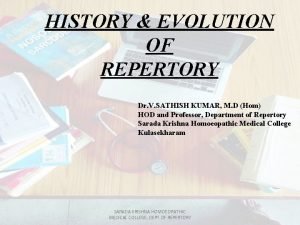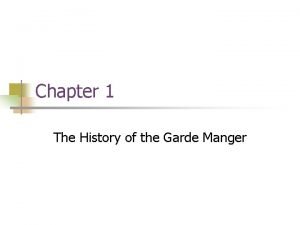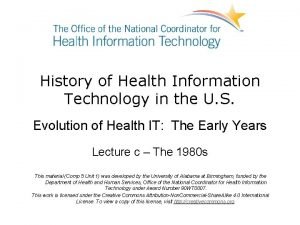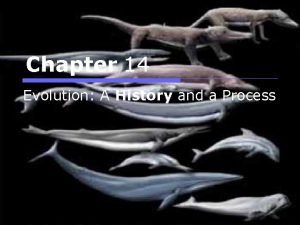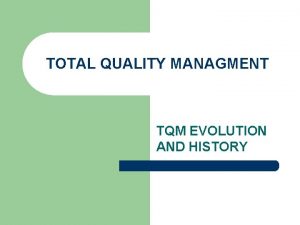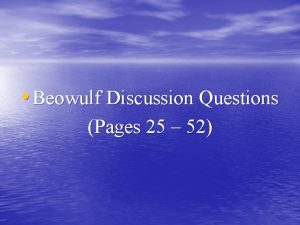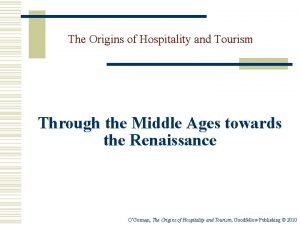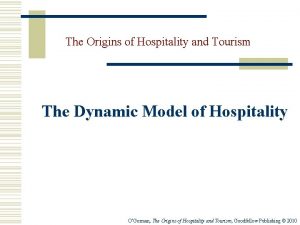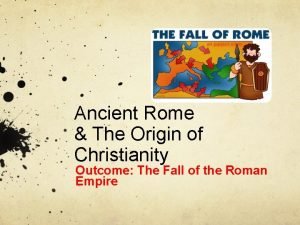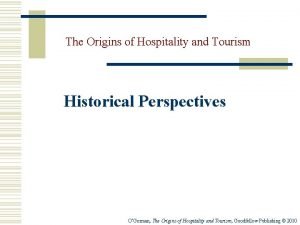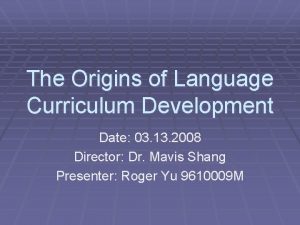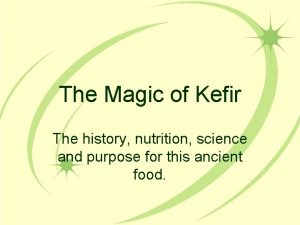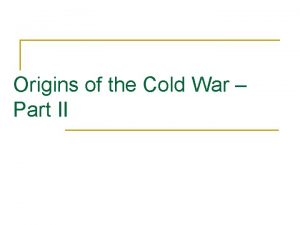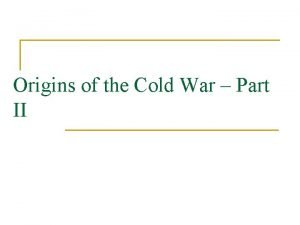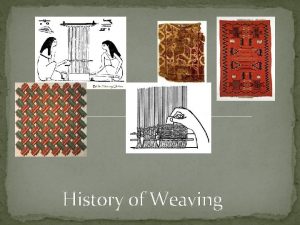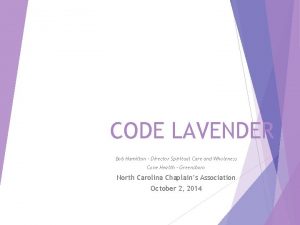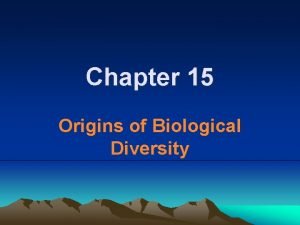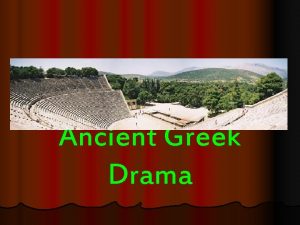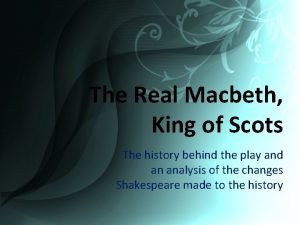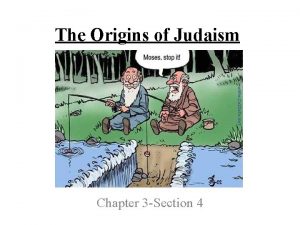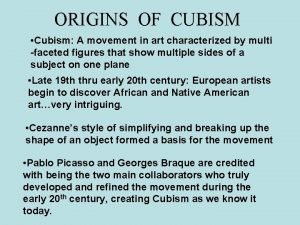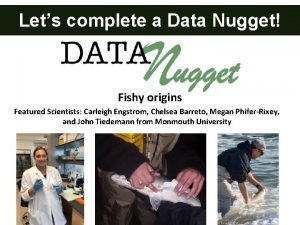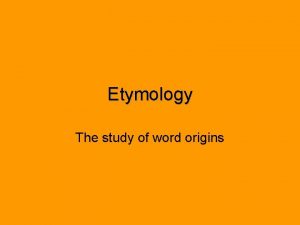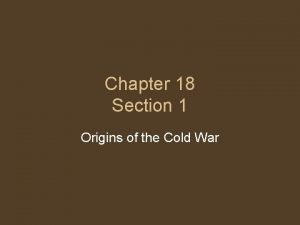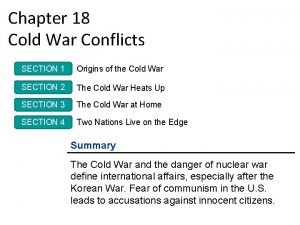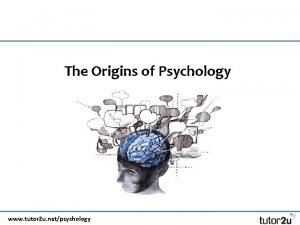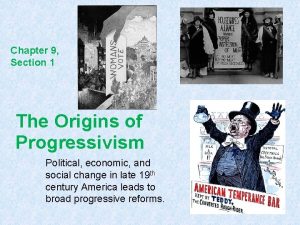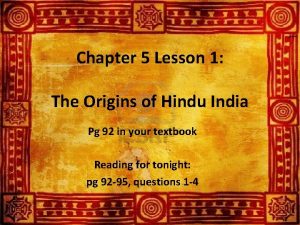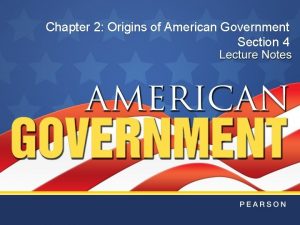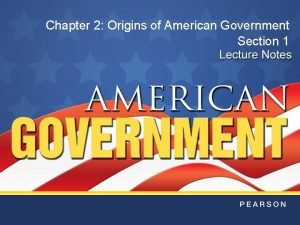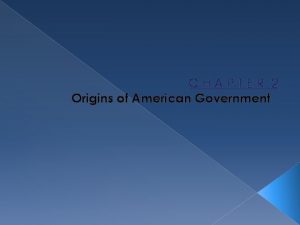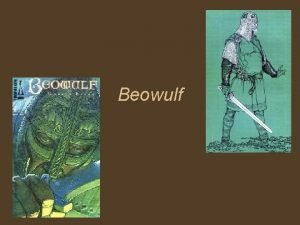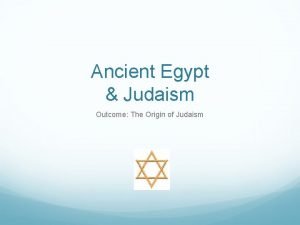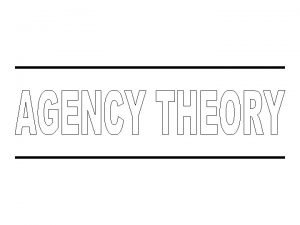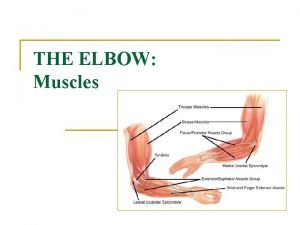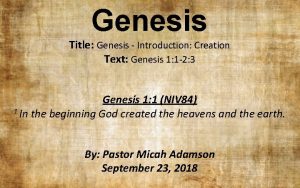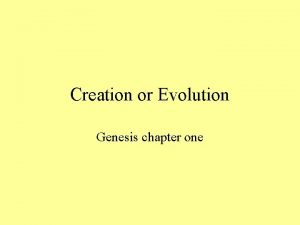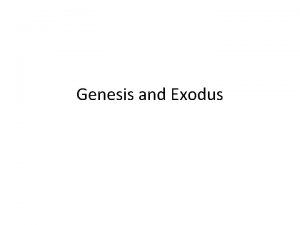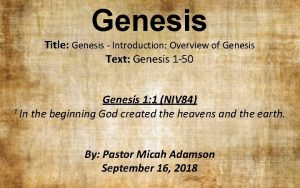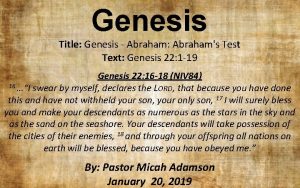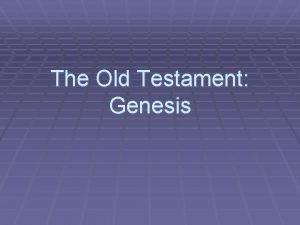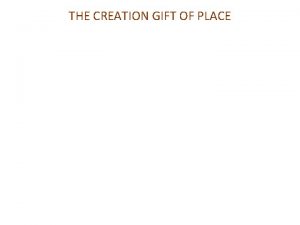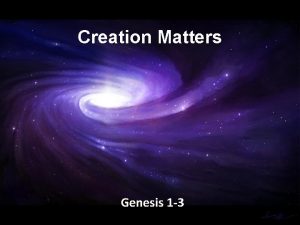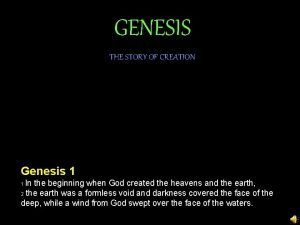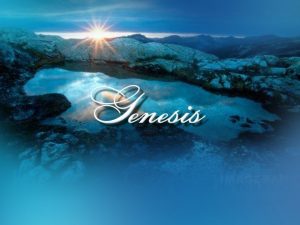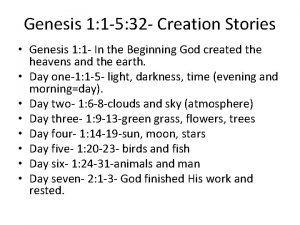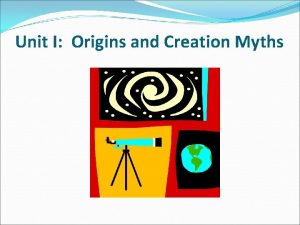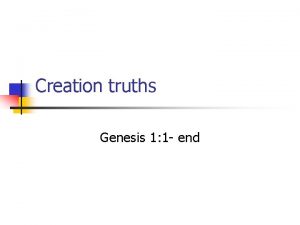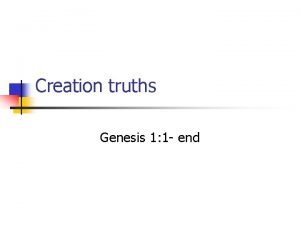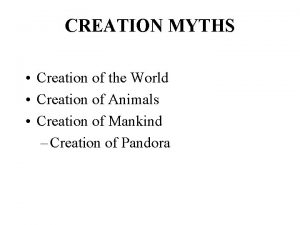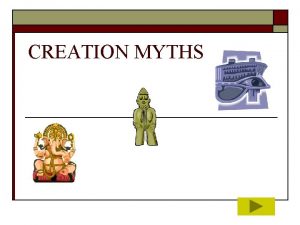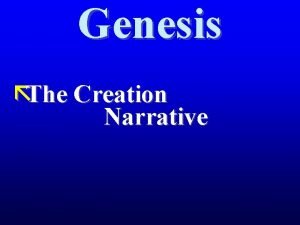A History of Origins Creation and Evolution Genesis































































- Slides: 63

A History of Origins: Creation and Evolution, Genesis and Science, and More Joe Mackes SREPC Adult Sunday School Mar - May 2017 1

Overview Week 1 (March 5) - Introduction, Scripture and Science Week 2 (March 12) – Genesis and Days of Creation Week 3 (March 19) - Different Views of Genesis Week 4 (March 26) – Creation and Evolution Models/Biology Week 5 (April 2) - Geology and the Fossil Record Week 6 (April 9) - Flood and Noah’s Ark Week 7 (April 16) – Dating Methods 2

Overview Week 8 (April 23) - Big Bang and Astronomy Week 9 (April 30) – No class Week 10 (May 7) – Starlight and Time/Wrap Up 3

Introduction • My background • Charles Templeton • 1 Pet 3: 15 4

Introduction • “But, Billy, it’s simply not possible any longer to believe, for instance, the biblical account of creation. The world wasn’t created over a period of days a few thousand years ago; it has evolved over millions of years. It’s not a matter of speculation; it’s demonstrable fact. ” • “Should one continue to base one’s life on a system of belief that—for all its occasional wisdom and frequent beauty—is demonstrably untrue? ” • Reasons Templeton gave for rejecting the faith: – Physicists who say ‘it took billions of years for the universe, our galaxy, our solar system, and our world to evolve to its present – Anthropologists who say that ‘our earlier ancestors did not suddenly appear fully formed, but were anthropoid creatures who lived on the earth millions of years ago. – Geologists who say ‘there is no evidence whatsoever of a worldwide flood’ as told in Genesis. – The ‘fables’ (in Genesis 1 and 2) which have ‘remained the grounds of Christian theology across the centuries. ’ – Noah and his family were too primitive to have built the Ark. – All the animals could not possibly have fitted on the Ark. – The ‘grim and inescapable reality’ that ‘all life is predicated on death. Every carnivorous creature must kill and devour another creature. It has no option. ’ • Conclusion in his autobiography “A Farewell to God”: – I believe that there is no supreme being with human attributes—no God in the biblical sense—but that all life is the result of timeless evolutionary forces … over millions of years. – I believe that, in common with all living creatures, we die and cease to exist as an entity. 5

Scripture • The Bible: – Is inspired (2 Tim 3: 16, 2 Pet 1: 21) • Presents objective propositional truth – Its words reveal true propositions, or facts about things, and can be interpreted according to the rules of grammar and historical context. • Scripture is and always will remain truth, whether or not we read and appropriate it personally – Is inerrant • Full inerrancy: Affirms the original manuscripts are without error in the things they assert. • Limited inerrancy: Affirms scripture is without error in matters of faith and practice but may include errors on matters such as history, geography, and science. – Daniel Fuller (Fuller Theological Seminary) divided scripture into two categories: » Revelational – matters that make us wise unto salvation » Non-revelational – matters of science, history, and culture that facilitate the transmission of the revelational. » Scripture only intends to convey truth about spiritual matters. 6

Scripture • Hermeneutics – Study of biblical interpretation – Determine what God meant, not what it means to me – Literal interpretation • Must be interpreted in its literal , or normal sense. The literal sense is the grammatical-historical sense. This takes into account all figures of speech and literary forms. – Lexical (word) and Syntactical (grammar, word combinations) • Words may take on a variety of meanings in different contexts, they generally have but one meaning in any given context. – Scripture interprets scripture – Exegesis • Derive understanding from (out of) the text • The task of the exegete is to determine as closely as possible what God meant in a particular passage, rather than what “it means to me”. – Eisegesis • Reading meaning into the text 7

Scripture • Perspicuity of scripture (is clear) – God intended ordinary people, with the help of the Holy Spirit, to be able to understand scripture without needing an elite group to interpret it. • Elite group in Reformation time was the Roman Church Magisterium • Rule of thumb: “If the plain sense makes sense, we should seek no other sense, lest we create nonsense. ” – The Timothy Test: • “Imagine a Jewish Christian of the first century who understands Greek, Hebrew, and the Scriptures well. Let’s call him “Timothy” since Paul’s protégé was called that. Let’s also imagine this Timothy knows nothing of advanced scientific knowledge of his day, such as Aristotle’s works. All that Timothy knows is from everyday experience or careful study of Scripture, which Paul says is sufficient for wisdom. Now if Scripture really is straightforward and sufficient, then the meaning Timothy derives from the words is probably the meaning that God intended for everybody to get. ” 8

Science • Operational (or Observational) science – Uses the scientific method: • Observation/Data collection • Formulate hypothesis • Experiment and test – Is repeatable – Is falsifiable – Examples: Classical mechanics, Thermodynamics • Historical (or origins) science – Uses circumstantial evidence to reconstruct the past • No direct observations (from the past) • Not falsifiable – Heavily influenced by beliefs and interpretations of the past – Examples: Biological evolution, Cosmology 9

Science • Martin Luther – magisterial and ministerial use of reason – Magisterial: Reason stands over Scripture like a magistrate and judges it. – Ministerial: Reason submits to Scripture. • Examples as applied to science: – Ministerial use of science: Elaborates on clear teachings of the bible, such as a worldwide year-long global flood occurred about 1, 600 years after creation. – Magisterial: To claim uniformitarian science disproves a global flood, so Genesis must be reinterpreted to mean a local flood or dismissed as unhistorical. – Ministerial: To study biology based on the assumption that living organisms reproduce “after their kind” per Gen 1. – Magisterial: To assume all life has evolved from a simple cell and reinterpret Genesis so that one kind has changed into another kind. 10

The Controversy • • • Both sides have the same evidence and facts Difference is in how the facts are interpreted, i. e. one’s presuppositions Two starting points (presuppositions): 1. God’s Word is truth • Revelation is the key to the past 2. Man decides truth • Present is the key to the past • Questions: – Who is an elite group today that is people use to interpret scripture? – Is the bible accurate about scientific matters it discusses? – Should nature be considered a 67 th book of the Bible, i. e. is general revelation equivalent to special revelation? 11

Week 2 – Genesis and Days of Creation 12 March 2017 12

Genesis • What is the most important verse in the bible? • God (Elohim) – All powerful creator • Created (Bara) – calls into existence that which had no existence, work of God (Rom 4: 17, Heb 11: 3) • Heaven (shamayim) - space • Earth (erets) – matter • Paraphrase (Henry Morris): The transcendent, omnipotent God called into existence the space-time mass universe. 13

Genesis • Reformation Study Bible says in introduction - “The tension between Genesis and modern science about the origins of the universe and of living species is largely resolved when it is recognized that they are speaking from different perspectives. Genesis is concerned about who created and why, not about how and when. Science cannot answer the former questions, and Genesis is largely mute about the latter. ” • Is Genesis 1 -11 and particularly Gen 1: 1 -2: 4 a historical narrative or should it be understood figuratively, allegorically, or mythically? 14

Genesis • • • Literary structure: – 1: 1 is an introductory statement, typical of Hebrew narrative – Rest of chapter 1 - how God created with focus on earth – 2: 4 is transition verse - moves focus from all of creation to mankind in Chapter 2 Literary genre types attributed to Genesis 1 -11: Historical narrative, poetry, theological narrative, hymn, exalted prose narrative, legend, or myth? – Gen 1 contains little or no indication of figurative language. – The main characteristic of Hebrew poetry, parallelism is missing • Example of synonymous parallelism is Psalm 19: 1 Some argue because Genesis 1 contains symmetry (such as having parallels between the six days of creation), and is not a normal historical narrative but an “artistic arrangement” with a theological not a historical emphasis. – This is a false dichotomy between history and theology. Even if true (the parallels are overstated), historical and theological parts are not mutually exclusive. 15

Genesis • Literal (historical-grammatical) approach to hermeneutics – Interpret the text plainly according to its literary genre. – Plain meaning may be understood as “the meaning intended by the human author, as that sense that can be plainly determined by the literary and historical context. ” • Takes into account metaphors and figures of speech (e. g. Gen 2: 23, 4: 7 , 7: 11). • Syntax – First day has a cardinal number without article (Day 1) – Days 2 -5 have ordinal numbers without article (second day, third day…) – Days 6 -7 have ordinal numbers with an article (the sixth day, the seventh day) • The Sixth Day – culminating day of creation • The Seventh Day – special day because God had finished creating and rested 16

Genesis 1 – Days of Creation • Lexical (word) study – Hebrew word for day in Genesis 1, yom, has following semantic range (possible meanings): • A period of 24 hours • A period of light in a day/night cycle • A general or indefinite concept of time • A specific point of time • A period of one year – Examples: • “In my father’s day, he would go to bed early Sunday evening and rise early in the morning of the following day, and spend the next six days traveling, during the day, to cross the whole country. ” • Gen 2: 4 – “…in the day that the Lord God made the earth and the heavens…. ” – Day in Gen 2: 4 is an idiomatic or figurative expression for “when”, context is totally different from Gen 1. – When used to describe an indefinite period, yom is always modified by a preposition like in Gen 2: 4 (not in Genesis 1) 17

Genesis 1 – Days of Creation • • Yom + Number – Yom + cardinal number (1, 2, 3) or Yom + ordinal number (1 st, 2 nd, 3 rd) • Occurs 359 times in OT outside of Gen 1 • Always means a literal day or the light portion of a day/night cycle, regardless of genre, except for: – Hosea 6: 2 – a type of poetic parallelism like Prov 6: 16, 30: 15 – Zech 14: 7 also debated • Clearest in numbered series of days, e. g. Gen 1, Num 7 and 29 Yom + evening and morning (ereb and boqer) – Combined with yom 19 times outside of Gen 1 – Always means a normal day regardless of genre or context Many lexicons use Gen 1 to define a normal day because meaning is so clear. Meaning of words must be determined by how they are used in the specific context of the passage, not by possible meanings in unrelated contexts. 18

Genesis – Days of Creation • Hebrew grammar in Gen 1: – Use of verb form “waw-consecutive” is an essential characteristic of narrative – “And” is formed by attaching the letter waw to the front of a Hebrew imperfect verb form. – Grammar indicates events happening in sequence (consecutively) – Used 55 times in Gen 1: 1 -2: 3 of which 46 are clearly sequential. – Gen 1 is written as account of events happening in a definite order. 19

Genesis - Other Scripture • Scripture interprets scripture: – Exo 20: 11 and 31: 17 indicate the events of Gen 1: 1 -2: 3 occurred in six days as the text plainly says. – New Testament authors cite Genesis 1 -11 as history: • Gen 1 -2 (Jesus): Matt 19: 4, Mark 10: 6 • Gen 2 -3 (Paul): Rom 5: 12, 1 Cor 15: 22, 2 Cor 11: 3, 1 Tim 2: 13 • Gen 6 -9 (flood): Matt 24: 37, 2 Pet 2: 5, Luke 17: 26 • Genealogies in Luke 3 and Heb 11 20

Genesis 1 -11 • Hebrew grammar shows Gen 1 -11 has same literary style as Gen 12 -50. – Gen 12 (call of Abram) makes little sense without genealogical links in Chapters 11 and 5. • Gen 12 begins with a waw-consecutive verb, “and he said”, indicating what follows is a continuation of chapter 11, not a major break in the narrative. • Genesis is structured on recurrence of the Hebrew phrase eleh toledoth (“This is the book of the genealogy of. . . ” or “This is the history of. . . ”). – Occurs 11 times throughout the book: 6 times in Genesis 1– 11 and 5 times in chapters 12– 50. – The author intended that both sections should be interpreted in the same way. 21

Genesis • James Barr, leading Hebrew scholar, and Oriel professor of the interpretation of Holy Scripture, Oxford University, England said: • He is a neo-orthodox interpreter so does not believe Genesis but says this about the Hebrew: • “…probably, so far as I know, there is no professor of Hebrew or Old Testament at any world-class university who does not believe that the writer(s) of Genesis 1 -11 intended to convey to their readers the ideas that: a) creation took place in a series of six days which were the same as the days of 24 hours we now experience. b) The figures contained in the Genesis genealogies provided by simple addition a chronology from the beginning of the world up to later stages in the biblical story, c) Noah’s flood was understood to be worldwide and extinguish all human and animal life except for those in the ark. ” 22

Genesis - Objections • • Light (day 2) before the sun (day 4) 2 Pet 3: 8 Days were “God days” not “man days” Too little time for all the tasks on day 6 23

Week 3 – Different Views of Genesis 19 March 2017 24

Different Views of Genesis • • • Young earth creationist/Calendar day/Biblical creationism Gap theory Day age/Progressive creationism Framework hypothesis Theistic evolution 25

YEC/Calendar Day • What is it? – Accept plain meaning of Genesis 1. – God created all things in six regular days. • • • Day 1 (1: 1 -5) - Heavens (space), earth (matter), time (implied) and light Day 2 (1: 6 -8) – Space/Sky (expanse/firmament) Day 3 (1: 9 -13) – Dry land, seas, and plants Day 4 (1: 14 -19) – Sun, moon, and stars Day 5 (1: 20 -23) – Sea creatures and birds Day 6 (1: 24 -31) – Land creatures and man – Creation is young based on genealogies from Adam on. – Worldwide flood caused the fossil record. 26

YEC/Calendar Day • History: – Majority of theologians prior to 1800’s held this view, including: • Ambrose, Basil, Luther, Calvin – Notable exceptions: • Clement and Origen of the Alexandrian school that allegorized scripture • Augustine (instantaneous creation) • All held to young earth – WCF “…in the space of six days…. ” language likely comes from Calvin, William Perkins and James Ussher • May have been added to rebut Augustine’s instantaneous view • All Genesis 1 commentaries from WCF authors held to this view: John White, John Ley, John Lightfoot, George Walker, and William Twisse • There is no evidence that any WCF author held to another view. • No reformed commentaries with other views until 1845, after the “new geology”. 27

YEC/Calendar Day • Theological Concerns: – None – Only view based on exegesis alone • Other Concerns: – Considered “anti-intellectual” due to prevailing scientific views 28

Gap Theory • What is it? – AKA ruin and reconstruction theory and pre-Adamic cataclysm theory – God created the world in Gen 1: 1 a long time ago, including animals and soul -less men. – Geological ages happened between Gen 1: 1 and 1: 2 – Satan rebelled and God judged the world, causing a great cataclysm which ended the geological ages and left the earth in darkness and covered in water. – God then re-created the world in six literal days per Gen 1: 3 -31. • Purpose: – To harmonize a “literal” view of Genesis 1 with the geological ages. • History: – Scottish theologian Thomas Chalmers (1780 -1847) – Theologian G. H. Pember, “Earth’s Earliest Ages”, 1884 – Included in footnote of Scofield Reference Bible in 1909. – Arthur C. Custance, “Without Form and Void”, 1970 29

Gap Theory • Theological Concerns: – Based primarily on eisegesis (reading into the text) – Poor exegesis • Genesis 1: 1 -2: In the beginning God created the heavens and the earth. The earth was without form, and void; and darkness was on the face of the deep. And the Spirit of God was hovering over the face of the waters • Reinterpret Gen 1: 2 from “The earth was without form and void…” to “The earth became ruined and desolate…. ” – All standard translations interpret Hebrew word hayetha as “was” not “became”. Nothing in context to indicate “became”. – Requires millions of years of death, disease and suffering before the fall (death before sin) – A very good creation? 30

Day Age/Progressive Creationism • What is it? – Accepts Big Bang age of universe about 14 billion years ago. – Days are interpreted as lasting millions/billions of years and can be overlapping. – Seventh day is continuing. – God progressively created new species over millions/billions of years. – Man-like creatures existed before Adam and Eve but did not have a soul made in the image of God. – Genesis flood was local. • Purpose: To harmonize a “literal” view of Genesis with the geological ages. 31

Day Age/Progressive Creationism • History: – Not codified until mid 1800’s, in response to the “new geology”, the belief that science has proven the earth is old. – Not accepted in the church until mid 1800’s with Hugh Miller’s book “Testimony of the Rocks” – Day age adherents: Charles and A. A. Hodge, B. B. Warfield, Machen, Boice – Progressive creationism popularized by Dr. Hugh Ross, Reasons to Believe ministry 32

Day Age/Progressive Creationism • Theological Concerns: – Based primarily on eisegesis and poor exegesis – Requires millions of years of death, disease and suffering before the fall, including soul-less man-like creatures (Romans 5: 12) – A very good creation? – Order of creative events in Genesis 1 is out of sequence Order of Appearance (Genesis) Order of Appearance (Day-Age) Earth created before sun/stars Sun/stars existed before earth Light on earth before sun Sun is earth’s first light First life is land plants First life is marine organisms Birds before land reptiles Reptiles before birds Whales before land mammals Land mammals before whales 33

Framework Hypothesis • What is it? – AKA framework interpretation or theory, literary framework view – Genesis 1 is a literary device teaching truths about creation and is not a historical narrative. – Creation “week” is a literary framework intended to present God’s creative activity in a topical, non-sequential manner. • “Exegesis indicates that the scheme of the creation week is a poetic figure and that the several pictures of creation history are set within the six work-day frames not chronologically but topically” • The week is a metaphor that Moses used to narrate God’s act of creation. 34

Framework Hypothesis • Primary aspects: 1. Figurative narrative of creation account with two triads of days (1 -3 and 4 -6) • Triads for literary and theological purposes, not chronological, that culminates in the sabbath. Days of Kingdom/Formation of World Days of Rulers/Filling of World Day 1: Light and darkness separated Day 4: Sun, moon and stars Day 2: Sky and waters separated Day 5: Fish and birds Day 3: Dry land seas separated, plants and trees Day 6: Animals and man 35

Framework Hypothesis 2. Ordinary Providence – Adherents believe Gen 2: 5 -6 describes the earth on the third day of creation and the reason that there were no plants of the field or herbs of the field was because God had not caused it to rain yet. They see this as evidence that God was not creating via miraculous means but through the same natural processes we observe today. 3. Unending nature of 7 th day indicates creation days are not normal days. – No evening and morning on 7 th day 36

Framework Hypothesis • History: – Developed by Arie Noordzij in 1924 – Meredith Kline of Westminster Seminary popularized view in US so popular in reformed circles • “Because it had not rained” article, 1958 • Purpose – “To rebut the literalist interpretation of the Genesis creation week propounded by young-earth theorists… The conclusion is that as far as the time frame is concerned, with respect to both the duration and sequence of events, the scientist is left free of biblical constraints in hypothesizing about cosmic origins. ” Meredith Kline 37

Framework Hypothesis • Theological Concerns: – Adherents claim it is based on exegesis. However, it is a new and novel view (foreign to the church for over 1900 years) intended to accommodate old earth views, so at its root it is eisegesis. – Triad of Days • Days of Genesis are not characteristic of Hebrew parallelism • Parallels do not stand up under scrutiny: – Day 4 sun/moon/stars better fit for day 2 sky/firmament then day 1 light/darkness – Day 5 fish/birds better fit for day 3 dry land/seas then day sky/waters – Nothing is created on day 6 to fill the day 3 seas 38

Framework Hypothesis • Theological concerns: – Ordinary providence • Gen 2: 5 -6 describes cultivated plants that man would produce after day 6 and not the plants created on day 3. • Ordinary providence during creation week is the same thing as uniformitarianism and an unbiblical philosophy that applies to all oldearth views. Just because miracles are not observed today does not mean they should be ruled out in the past, particularly for creation which in itself is supernatural and miraculous. – 7 th day continues – Gen 2: 2 -3 and Exo 20: 11 makes clear the 7 th day ended. God rested, blessed, and sanctified the day, all past tense. – No exegetical support for 7 th day continuing in Heb 4 – Allows for millions of years of death, disease and suffering before the fall, including soul-less man-like creatures – A very good creation? 39

Theistic Evolution • What is it? – AKA evolutionary creation – One who believes God providentially acted at some point in history to bring about the world as seen today. Typical views include God guiding all of the following: • Universe is about 14 billion years old and Big Bang explains origin of universe. • Earth formed about 4. 5 billion years ago • Life evolved on earth as chemicals interacted to form the first living organism • Organisms increased in complexity over time with all life on earth sharing a common ancestor. – Accepts mainstream science but not naturalism (which is foundational to mainstream science). – Some accept historical Adam, some do not. 40

Theistic Evolution • Purpose: To harmonize scripture with evolution and long ages • Popularized recently via Biologos (2007) – “The bible is the inspired and the authoritative word of God”. • Evangelical adherents: Tim Keller, Francis Collins, Bruce Waltke, Os Guiness • Theological concerns: – Where do we start? 41

Week 4 - Creation and Evolution Models/ Biology 26 March 2017 42

Starting Points • Both evolutionists and creationists have the same facts/data/evidence • Difference is how those facts are interpreted. • Facts are always interpreted according to a framework. • Each side has different starting points/assumptions/presuppositions/biases • Question is whose biases are correct • It is not that evolution is based on objective science and creation is based on subjective faith. • They are competing views of origins and both have scientific and philosophical/ religious components. • They are both equally valid as scientific hypothesis regarding the origin of life. 43

Myth of the Objective Scientist • • • “Science is fundamentally a game. It is a game with one overriding and defining rule: Rule #1: Let us see how far and to what extent we can explain the behavior of the physical and material universe in terms of purely physical and material causes, without invoking the supernatural. ” Evolutionary biologist Dr. R. E. Dickerson, Perspectives on Science and the Christian Faith, 1992 ”Evolution is a theory universally accepted not because it can be proven by logically coherent evidence to be true, but because the only alternative, special creation, is clearly incredible. ” Dr. D. M. S. Watson, Nature, 1929. “We take the side of science in spite of the patent absurdity of some of its constructs, in spite of its failure to fulfill many of its extravagant promises of health and life, in spite of the tolerance of the scientific community for unsubstantiated just-so stories, because we have a prior commitment, a commitment to materialism. It is not true that the methods and institutions of science somehow compel us to accept a material explanation of the phenomenal world, but, on the contrary, that we are forced by our a priori adherence to material causes to create an apparatus of investigation and a set of concepts that produce material explanations, no matter how mystifying to the uninitiated. Moreover, that materialism is an absolute, for we cannot allow a Divine Foot in the door. ” Dr. Richard Lewontin, New York Review, 1997. 44

Creation Model • Creation/Fall/Flood • God created the universe, earth and all life in six days, a “very good” creation, about 6, 000 years ago. • God created the original kinds of animals that reproduced “after their kind”. • Creation was cursed as a result of the fall introducing disease, suffering, and death for man and animals. • The Flood killed all land animals (land vertebrates) except for Noah and his family and the animals on the ark, about 4, 500 years ago. • Existing species of land animals are descended from the animals that left the ark primarily through natural selection. 45

Evolution Definitions • • Change over time – meaningless General theory of evolution - theory that all living forms in the world have arisen from a single source which itself came from an inorganic form Theory that all life forms descended from one or several common ancestors that were present on early earth, three to four billion years ago. Idea that living things are related to one another through common ancestry from earlier forms that differed from them. Darwin called this “descent with modification”. Is “unpredictable and natural” and has “no specific direction or goal” Source: Teaching about Evolution and the Nature of Science, National Academy of Sciences, 1998. Chemical evolution – non-organic life to the first living single celled reproducing organism. Biological evolution - common descent of all life from the first reproducing organism. Molecules to man/Particles to people/Fish to philosopher 46

Biological Evolution Model • • • • • Single celled organism – 3. 5 BY Plant ancestors – 1. 5 BY Multi-celled life - 900 MY Marine invertebrates – 580 MY Marine vertebrates – 530 MY Land plants – 465 MY Insects – 400 MY Trees – 385 MY Amphibians – 340 MY Reptiles – 310 MY Dinosaurs – 200 MY Birds – 150 MY Land mammals – 140 MY Flowering plants – 130 MY Rodents – 75 MY Primate ancestors – 75 MY Grasses – 70 MY Whale and dolphin ancestors – 50 MY Apes – 25 MY Humans – 6 MY • Source: Timeline the Evolution of Life, M. Marshall, New Scientist, 2009. 47

Creation and Evolution Models • • Evolution Tree – single common ancestor for all life Creation Orchard – Arising from separate created kinds 48

Similarity/Homology • Similarities in structures and DNA are claimed to be evidence for evolution (common ancestor). • All such similarities fit the creation model and are evidence of a designer using common design features 49

Natural Selection • • AKA Selection/Adaptation/Variation/Survival of the Fittest Originated by William Blythe, a creationist, 25 years before Darwin Explains how species adapt to their environment and features can change Darwin’s finches: • Darwin believed the small observed changes he saw could be extrapolated over a very long time and explain the origin of the species. Virtually every example of evolution is natural selection/variation within a kind and sorts out existing genetic information: – Peppered moths – Bacteria “evolved” resistance to antibiotics – Mosquitos “evolved” resistance to DDT • 50

Natural Selection • • • Natural selection is a conservative not an innovative (creative) process. It does not add information, it selects on existing information and actually reduces genetic information, and is the opposite of what is required for evolution to occur. Natural selection results in a loss of genetic information as species become more specialized adapting to their environment. Artificial selection (e. g. dog breeding) is similar to natural selection. 51

Mutations • Mutations are genetic copying mistakes, inherited glitches, we all have hundreds of defects from previous generations • Neo-Darwinism attributes the creative force behind evolution to be genetic mutations, with natural selecting working through mutations, to produce all of the new information needed. • Mutations are almost always harmful but in rare cases can be beneficial. • Mutations reduce genetic information and do not increase it. – Even if a few mutations did increase genetic information, that would not support the enormous quantity of information required to evolve from molecules to man. 52

Mutations “In all the reading I’ve done in the life sciences literature I’ve never found a mutation that added information. All point mutations that have been studied on the molecular level turn out to reduce the genetic information and not to increase it. Neo-Darwinian theory is supposed to explain how the information of life has been built up by evolution. The essential biological difference between a human and a bacterium is in the information they contain. All other biological differences follow from that. The human genome has much more information than does the bacterial genome. Information cannot be built up by mutations that lose it. A business can’t make money by losing it a little at a time. ” Source: Lee Spetner, Not By Chance, 1998 53

Design • • • Randomness: WOTXMAOQGEXI Order – repetitive low information sequence – Examples: Crystals, ABCABCABC Specified Complexity – a particular ordered sequence that conveys information – Examples: Jesus is Lord, To be or not to be Specified complexity and information cannot originate solely from matter and energy, requires an intelligence – SETI program looks for specified complexity to determine if life is out there Irreducible Complexity – Must be fully formed to be functional with all parts working together – Mousetrap – Many biological examples at molecular and functional levels: – Rotary motors in bacteria flagella and making the ATP molecule which is a critical energy source in the cell vital for life – Blood clotting system 54

Molecular Biology “To grasp the reality of life as it has been revealed by molecular biology, we must magnify a cell a thousand million times until it is twenty kilometers in diameter and resembles an airship large enough to cover a great city like London or New York. What we would then see would be an object of unparalled complexity and adaptive design. On the surface of the cell we would see millions of openings, like the port holes of a vast space ship, opening and closing to allow a continual stream of materials to flow in and out. If we were to enter one of those openings we would find ourselves in a world of supreme technology and bewildering complexity. Is it really credible that random processes could have constructed a reality, the smallest element of which, a functional protein or gene, is complex beyond our own creative capacities, a reality which is the very antithesis of chance, which excels in every sense anything produced by the intelligence of man? It would be an illusion to think that we are aware of at present is any more than a fraction of the full extent of biological design. In practically every field of fundamental biological research ever-increasing levels of design and complexity are being revealed at an ever-accelerating rate. Source: Michael Denton, A Theory in Crisis, 1986. 55

Molecular Biology - Definitions • Amino Acids: Molecular building blocks of proteins • Proteins: Molecule made from amino acids that perform many different functions in the body; mini machines that build structures and carry out chemical reactions necessary for life. • Genes: DNA sequences that instruct cells to produce particular proteins which in turn determine traits. • Chromosomes: Strings of genes • DNA: Deoxyribonucleic acid , a large molecule with a double helix structure in the nucleus of a cell; Contains genes • RNA: Ribonucleic acid used by cells to make proteins. 56

Molecular Biology & DNA • • Summary: Genes tell the cell to make certain proteins. DNA and RNA work together to produce these proteins using the cell’s genetic code. DNA is the information molecule of life and contains the recipe or instruction book to make life at a molecular level. – Contains the blueprint for all proteins required for life and the code for building and running life’s complex organs – Includes the instructions for both the coding and decoding systems – Analogy: • Book – 2 parallel ropes • Chapter – 23 chromosomes (one/parent) • Paragraph – Genes • Letters - Chemicals A, T, C, G (base pairs) – Human DNA has 3. 1 billion letters, is about 6 feet long if stretched out and intricately folded – A pinhead size of DNA is equivalent to about 10 million 400 GB hard drives 57

DNA Similarity • • • Evolution requires huge amounts of information to be added – For example bird lungs are completely different from reptile lungs and of exquisite engineering design. Human and chimp DNA are considered to be about 96% similar – That is arguable as recent studies by creationists indicate it may be much less. Assuming it is 96%, the 4% difference means there would have to be mutations that account for 120 million changes in DNA base pairs (4% of 3 billion). Human DNA is roughly equivalent to 1, 000 500 page books, so 4% would require making 40 new large books. Population genetic calculations show animals with human like generation times of 20 years could only produce about 1, 700 mutations in 10 MY. There are vast differences between all types of creatures that evolution cannot account for at the micro-cellular level. 58

Chemical Evolution • • Louis Pasteur – Showed that life only comes from life; disproved theory of spontaneous generation; yet that is the first step required in evolution. – Law of Biogenesis: Life only comes from life Simplest known cell: Mycoplasma genitallum – 482 genes, 580, 000 DNA letters, but must be a parasite to live, so insufficient. It is statistically impossible to create even the simplest single celled organism via random natural processes. – A million monkeys typing on a keyboard would take 1. 35 x 1016 years to type the simple phrase “to be or not to be” at 1 keystroke/second. Miller-Urey experiment, 1953 – Produced some amino acids (building blocks of proteins) in a reducing (non oxygen) environment with methane, ammonia & hydrogen – Problems: • Produced left and right handed amino acid; all in life are left-handed (homochirality) • Early earth had oxygen per oldest rocks which would not allow amino acids to form. – Experiment showed that with high intelligence some non-living amino acids could be produced, not life. 59

The Fruit of Evolution “Modern science directly implies that the world is organized strictly in accordance with mechanistic principles. There are no purposive principles whatsoever in nature. There are no gods and no designing forces that are rationally detectable… Second, modern science directly implies that there are no inherent moral or ethical laws, no absolute guiding principles for human society. Third, human beings are marvelously complex machines. The individual human becomes an ethical person by means of two primary mechanisms, heredity and environmental influences. That is all there is. Fourth, we must conclude that when we die, we die and that is the end of us. Finally free will as traditionally conceived – the freedom to make uncoerced and unpredictable choices among alternative possible courses of action – simply does not exist…There is no way that the evolutionary process as currently conceived can produce a being that is truly free to make choices…” Source: Dr. W. Provine, Cornell University, Five Lies of Century, D. Moore, 1995. 60

• Evolution is a failed scientific hypothesis and is believed in spite of the overwhelming evidence against it because the only other alternative (special creation) is untenable. • Given eons of time, frogs really can turn into princes • Evolution is an anti-biblical worldview, really a religion • Col 2: 8 61

Biblical Genealogy Timeline of the Patriarchs 0 250 500 750 1000 1250 1500 1750 2000 2250 2500 Adam, 930 Seth, 912 Enosh, 905 Cainan, 910 Mahalalel, 895 Jared, 962 Enoch, 365 Methuselah, 969 Lamech, 777 Noah, 950 Shem, 600 Arphaxad, 438 Salah, 433 Eber, 464 Peleg, 239 Reu, 239 Serug, 230 Nahor, 148 Terah, 205 Abram (Abraham), 175 Isaac, 180 Jacob, 147 Joseph, 110 Developed by Scott Whiteman 62

Next Week Geology and the Fossil Record 63
 History of repertory
History of repertory Facility management history and evolution
Facility management history and evolution Garde manger duties
Garde manger duties Boger synoptic key ppt
Boger synoptic key ppt History of kent repertory
History of kent repertory History and evolution of health information technology
History and evolution of health information technology Chapter 14 evolution a history and a process
Chapter 14 evolution a history and a process Evolution of total quality management
Evolution of total quality management Hip and leg muscles
Hip and leg muscles Datagram approach
Datagram approach The origins and spread of christianity
The origins and spread of christianity Is beowulf italicized
Is beowulf italicized How do the origins of folk and popular culture differ
How do the origins of folk and popular culture differ How do the origins of folk and popular culture differ?
How do the origins of folk and popular culture differ? Lesson 1 purposes and origins of government answer key
Lesson 1 purposes and origins of government answer key The origins of hospitality and tourism
The origins of hospitality and tourism The origins of hospitality and tourism
The origins of hospitality and tourism Ancient rome and the origins of christianity
Ancient rome and the origins of christianity The origins of hospitality and tourism
The origins of hospitality and tourism B.i.ø
B.i.ø The origins of sociology
The origins of sociology The origin of language curriculum development
The origin of language curriculum development Tentaizu
Tentaizu Hunger games chapter 14 questions and answers
Hunger games chapter 14 questions and answers Historical origins of the health belief model
Historical origins of the health belief model Rastafari origins
Rastafari origins Cwv 101
Cwv 101 Origins of the cold war
Origins of the cold war Origins of the cold war
Origins of the cold war History of weaving
History of weaving Where did judo originate
Where did judo originate Origins of tennis
Origins of tennis Root word anthrop
Root word anthrop Place of origin of
Place of origin of Earl bakken quotes
Earl bakken quotes Chapter 15 origins of biological diversity answers
Chapter 15 origins of biological diversity answers Origins of theatre
Origins of theatre Real macbeth
Real macbeth Chapter 3 section 4 the origins of judaism answer key
Chapter 3 section 4 the origins of judaism answer key Origins of cubism
Origins of cubism Datanugget
Datanugget Buddhism
Buddhism Study of word origins
Study of word origins History of a community
History of a community Chapter 18 section 1 origins of the cold war
Chapter 18 section 1 origins of the cold war Origins of the cold war chapter 18 section 1
Origins of the cold war chapter 18 section 1 Origins of american government vocabulary
Origins of american government vocabulary Introspection tutor2u
Introspection tutor2u Origins of cricket
Origins of cricket Where did hinduism originate
Where did hinduism originate The origin of species manhwa 24
The origin of species manhwa 24 Jazz dance history
Jazz dance history Halloween has its origins in which ancient celtic festival
Halloween has its origins in which ancient celtic festival The origins of progressivism chapter 9 section 1
The origins of progressivism chapter 9 section 1 Lesson 1 origins of hindu india answers
Lesson 1 origins of hindu india answers Origins of american government section 4
Origins of american government section 4 Chapter 2 origins of american government answer key
Chapter 2 origins of american government answer key Chapter 2: origins of american government worksheet answers
Chapter 2: origins of american government worksheet answers Beowulf origins
Beowulf origins Origin
Origin Origins of agency theory
Origins of agency theory Unit 7 lesson 4 medians and altitudes
Unit 7 lesson 4 medians and altitudes Anconeus muscle
Anconeus muscle Yüan-shih t'ien-tsun
Yüan-shih t'ien-tsun
